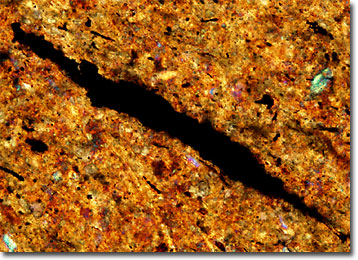Polarized Light Microscopy Digital Image Gallery
Arenaceous Shale
Shale is a type of fine-grained sedimentary rock that typically exhibits a laminated structure. Due to this structure, shales readily split into thin layers along planes parallel to the bedding surface.

View a second image of Arenaceous Shale
The most prevalent of all sedimentary rocks, shale comprises a significant portion of the Earth’s crust and can be found around the world. Deposits of shale most often occur nearby lagoons, rivers, floodplains, and beaches because the slow moving water in such areas tends to carry and accrete the silt, mud, and sediments from which the rock is formed. Thus, most shales also form in thick, expansive sheets, since the particles of these materials tend to settle into layers. Sometimes within large beds of shale, sheets of other rocks, such as limestone or sandstone, are present.
Generally, shales contain large amounts of clay minerals and quartz, but are otherwise somewhat various in their composition and appearance. Some types of the rock contain significant amounts of organic material and may be utilized as a source of oil. These organic-rich shales tend to be very darkly colored. Aranaceous shale, however, is a kind of shale that contains appreciable amounts of sand and may exhibit a wide variety of hues. For instance, an arenaceous shale deposit in Sweden is a greenish-gray color, while in Kansas occurrences of the rock are red, and in China examples have been found that are a purplish hue. The red and purple coloring of shales is typically an indication of the presence of hematite or limonite, and mineral constituents that contain large amounts of ferrous iron are usually responsible for green, black, and blue shales.
